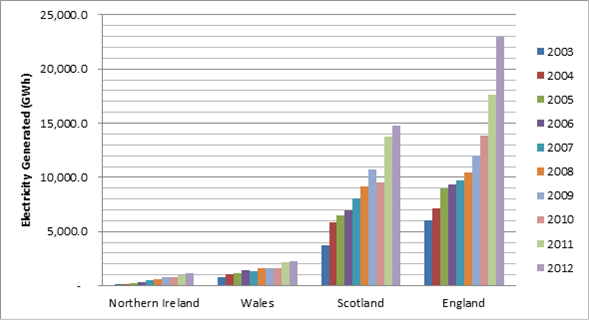Article written by Graham Winter, National Assembly for Wales Research Service
Last week’s 2013 Autumn Statement saw a shift in UK Government financial support for renewable energy, from on-shore wind to off-shore wind. This blog post looks at the latest statistics for renewable energy that have been published by the Department of Energy and Climate Change (DECC) covering the period 2003 to 2012. Further detailed statistics are available in the research paper Renewable Energy in Wales: in figures. The statistics outline the amount of energy produced by renewable sources as well as the total number of renewable energy installations. They are broken down for the different administrations of the UK, allowing comparisons to be made on the progress of each country in increasing renewable energy production. Energy produced from renewable resources increased by just 93 GigaWatt hours (4%) between 2011-2012 in Wales. This compared with 18%, 7% and 30% increases in Northern Ireland, Scotland and England respectively. Electricity Generated from Renewable Sources 2003-2012  The number of installations (excluding solar) has increased far more rapidly with a 40% increase (from 352 to 493 installations) in Wales and 25%, 70% and 50% increases respectively in Northern Ireland, Scotland and England. This reflects an increase in small scale schemes that, whilst numerous, do not generate much energy. Solar installations have increased even more rapidly, from 16,000 to 27,000, and they now account for 98% of installations within Wales but only 3% of the generated energy. This again reflects the nature of solar installations, typically being domestic with a low generation capacity. The rapid increase in the number of installations has been driven by Feed In Tariffs. The proportion of the electricity produced by each type of renewable energy in each country shows some large differences. The high proportion of energy generated by wind in the three devolved administrations and by hydro in Scotland reflects the large natural capacity these countries have from high wind speeds and sources suitable for hydro. The large amount of bioenergy produced in England comes predominantly from Tilbury B, a coal power station converted to burn biomass. Electricity Generation by Renewable Energy Source for 2012
The number of installations (excluding solar) has increased far more rapidly with a 40% increase (from 352 to 493 installations) in Wales and 25%, 70% and 50% increases respectively in Northern Ireland, Scotland and England. This reflects an increase in small scale schemes that, whilst numerous, do not generate much energy. Solar installations have increased even more rapidly, from 16,000 to 27,000, and they now account for 98% of installations within Wales but only 3% of the generated energy. This again reflects the nature of solar installations, typically being domestic with a low generation capacity. The rapid increase in the number of installations has been driven by Feed In Tariffs. The proportion of the electricity produced by each type of renewable energy in each country shows some large differences. The high proportion of energy generated by wind in the three devolved administrations and by hydro in Scotland reflects the large natural capacity these countries have from high wind speeds and sources suitable for hydro. The large amount of bioenergy produced in England comes predominantly from Tilbury B, a coal power station converted to burn biomass. Electricity Generation by Renewable Energy Source for 2012  Note: The “wind and wave” figures are predominantly wind (onshore and offshore). Separate figures are not available. The largest source of the increase in renewable energy electricity generation for England, Scotland and Northern Ireland between 2011and 2012 came from wind. Total wind (and wave) installations increased in Wales, from 204 to 341, however the production capacity only increased by 5%. The actual increase in electricity generation from wind and wave was even lower (0.7%). Change in Electricity Generated from Renewable Energy Sources 2011-2012
Note: The “wind and wave” figures are predominantly wind (onshore and offshore). Separate figures are not available. The largest source of the increase in renewable energy electricity generation for England, Scotland and Northern Ireland between 2011and 2012 came from wind. Total wind (and wave) installations increased in Wales, from 204 to 341, however the production capacity only increased by 5%. The actual increase in electricity generation from wind and wave was even lower (0.7%). Change in Electricity Generated from Renewable Energy Sources 2011-2012 






